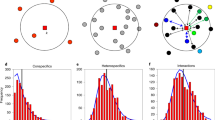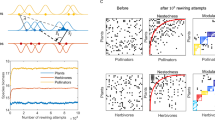Abstract
Ecological theory suggests that coexistence of many species within communities requires negative frequency-dependent feedbacks to prevent exclusion of the least fit species. For plant communities, empirical evidence of negative frequency dependence driving species coexistence and diversity patterns is rapidly accumulating, but connecting these findings to theory has been difficult as corresponding theoretical frameworks only consider small numbers of species. Here, we show how frequency-dependent feedback constrains community coexistence, regardless of the number of species and inherent fitness inequalities between them. Any interaction network can be characterized by a single community interaction coefficient, IC, which determines whether community-level feedback is positive or negative. Negative feedback is a necessary (but not sufficient) condition for persistence of the entire community. Even in cases where the coexistence equilibrium state cannot recover from perturbations, IC < 0 can enable species persistence via cyclic succession. The number of coexisting species is predicted to increase with the average strength of negative feedback. This prediction is supported by patterns of tree species diversity in more than 200,000 deciduous forest plots in the eastern United States, which can be reproduced in simulations that span the observed range of community feedback. By providing a quantitative metric for the strength of negative feedback needed for coexistence, we can now integrate theory and empirical data to test whether observed feedback–diversity correlations are strong enough to infer causality.
This is a preview of subscription content, access via your institution
Access options
Access Nature and 54 other Nature Portfolio journals
Get Nature+, our best-value online-access subscription
$29.99 / 30 days
cancel any time
Subscribe to this journal
Receive 12 digital issues and online access to articles
$119.00 per year
only $9.92 per issue
Buy this article
- Purchase on Springer Link
- Instant access to full article PDF
Prices may be subject to local taxes which are calculated during checkout




Similar content being viewed by others
References
MacArthur, R. & Levins, R. The limiting similarity, convergence and divergence of coexisting species. Am. Nat. 101, 377–385 (1967).
Tilman, D. Competition and biodiversity in spatially structured habitats. Ecology 75, 2–16 (1994).
Tilman, D. Resource Competition and Community Structure (Princeton Univ. Press, Princeton, 1982).
Clark, J. S. Individuals and the variation needed for high species diversity in forest trees. Science 327, 1129–1132 (2010).
Allesina, S. & Levine, J. A competitive network theory for species diversity. Proc. Natl Acad. Sci. USA 108, 5638–5642 (2011).
Chesson, P. Mechanisms of maintenance of species diversity. Ann. Rev. Ecol. Evol. Syst. 31, 343–366 (2000).
Barabás, G., Michalska-Smith, M. J. & Allesina, S. The effect of intra- and interspecific competition on coexistence in multispecies communities. Am. Nat. 188, E1–E12 (2016).
Adler, P., HilleRisLambers, J. & Levine, J. A niche for neutrality. Ecol. Lett. 10, 95–104 (2007).
Comita, L. S., Muller-Landau, H. C., Aguilar, S. & Hubbell, S. P. Asymmetric density dependence shapes species abundances in a tropical tree community. Science 329, 330–332 (2010).
Mangan, S. A. et al. Negative plant–soil feedback predicts tree-species relative abundance in a tropical forest. Nature 466, 752–756 (2010).
Johnson, D. J., Beaulieu, W. T., Bever, J. D. & Clay, K. Conspecific negative density dependence and forest diversity. Science 336, 904–907 (2012).
LaManna, J. A. et al. Negative density dependence mediates biodiversity–productivity relationships across scales. Nat. Ecol. Evol. 1, 1107–1115 (2017).
LaManna, J. A. et al. Plant diversity increases with the strength of negative density dependence at the global scale. Science 356, 1389–1392 (2017).
Hofbauer, J. & Sigmund, K. Evolutionary Games and Population Dynamics (Cambridge Univ. Press, Cambridge, 1998).
Allesina, S. & Tang, S. Stability criteria for complex systems. Nature 483, 205–208 (2012).
Bascompte, J., Jordano, P. & Olesen, J. M. Asymmetric coevolutionary networks facilitate biodiversity maintenance. Science 312, 431–433 (2006).
Chisholm, R. A. & Muller-Landau, H. A theoretical model linking interspecific variation in density dependence to species abundances. Theor. Ecol. 4, 241–253 (2010).
Bever, J. D., Kristi, M. W. & Antonovics, J. Incorporating the soil community into plant population dynamics: the utility of the feedback approach. J. Ecol. 85, 561–573 (1997).
Bever, J. D. Soil community feedback and the coexistence of competitors: conceptual frameworks and empirical tests. New Phytol. 157, 465–473 (2003).
Kulmatiski, A., Heavilin, J. & Beard, K. H. Testing predictions of a three-species plant–soil feedback model. J. Ecol. 99, 542–550 (2011).
Van der Putten, W. H., Van Dijk, C. & Peters, B. A. M. Plant-specific soil-borne diseases contribute to succession in foredune vegetation. Nature 362, 53–56 (1993).
Revilla, T., Veen, G. F., Eppinga, M. B. & Weissing, F. J. Plant–soil feedbacks and the coexistence of competing plants. Theor. Ecol. 6, 99–113 (2013).
Mack, K. M. L. & Bever, J. D. Coexistence and relative abundance in plant communities are determined by feedbacks when the scale of feedback and dispersal is local. J. Ecol. 102, 1195–1201 (2014).
Levins, R. The qualitative analysis of partially specified systems. Ann. NY Acad. Sci. 231, 123–138 (1974).
Wissel, C. A universal law of the characteristic return time near thresholds. Oecologia 65, 101–107 (1984).
Bennincà, E., Ballantine, B., Ellner, S. P. & Huisman, J. Species fluctuations sustained by cyclic succession at the edge of chaos. Proc. Natl Acad. Sci. USA 112, 6389–6394 (2015).
Klironomos, J. N. Feedback with soil biota contributes to plant rarity and invasiveness in communities. Nature 417, 67–70 (2002).
Neutel, A. M. et al. Reconciling complexity with stability in naturally assembling food webs. Nature 449, 599–602 (2007).
De Deyn, G. B. et al. Soil invertebrate fauna enhances grassland succession and diversity. Nature 422, 711–713 (2003).
Mazzoleni, S. et al. Inhibitory and toxic effects of extracellular self-DNA in litter: a mechanism for negative plant–soil feedbacks? New Phytol. 205, 1195–1210 (2015).
Johnson, D. J., Beaulieu, W. T., Bever, J. D. & Clay, K. Response to comment on “Conspecific negative density dependence and forest diversity”. Science 338, 469 (2012).
Dickie, I. A., Hurst, J. M. & Bellingham, P. J. Comment on “Conspecific negative density dependence and forest diversity”. Science 338, 469 (2012).
Acknowledgements
This work was conducted as part of the ‘Plant–soil feedback theory’ Working Group at the National Institute for Mathematical and Biological Synthesis, sponsored by the National Science Foundation through NSF Award DBI-1300426, with additional support from The University of Tennessee, Knoxville. The work was further supported by NSF grant DEB-1738041, awarded to J.D.B. We thank K. C. Abbott, J. Bauer, L. S. Comita, K. M. Crawford, S. A. Mangan, J. Umbanhowar and K. N. Suding for discussions of this work during working group meetings, J. Aning for assistance with the FIA data analysis, and T. Markus for assistance with the preparation of the figures. We also thank F. May for comments that improved the manuscript. Finally, we thank all of the FIA employees who collected the data that enabled us to test model predictions.
Author information
Authors and Affiliations
Contributions
M.B.E., D.J.J., K.M.L.M., A.E.S. and J.D.B. designed the study. M.B.E. and M.B. performed the analytical model analyses. M.B.E., M.B., J.J., K.M.L.M. and A.E.S. developed the code, and performed and analysed the model simulations. M.B.E., M.B., D.J.J. and J.D.B. analysed the field observation data. M.B.E. and J.D.B. wrote the first draft, after which all authors contributed to improving the manuscript.
Corresponding author
Ethics declarations
Competing interests
The authors declare no competing interests.
Additional information
Publisher’s note: Springer Nature remains neutral with regard to jurisdictional claims in published maps and institutional affiliations.
Supplementary information
Supplementary Information
Supplementary Information sections 1–7 and Supplementary Figures 1–13
Supplementary Table 1
A spreadsheet containing the values of average pair-wise feedback summarized in Fig. 4b of the main text
Rights and permissions
About this article
Cite this article
Eppinga, M.B., Baudena, M., Johnson, D.J. et al. Frequency-dependent feedback constrains plant community coexistence. Nat Ecol Evol 2, 1403–1407 (2018). https://doi.org/10.1038/s41559-018-0622-3
Received:
Accepted:
Published:
Issue Date:
DOI: https://doi.org/10.1038/s41559-018-0622-3



